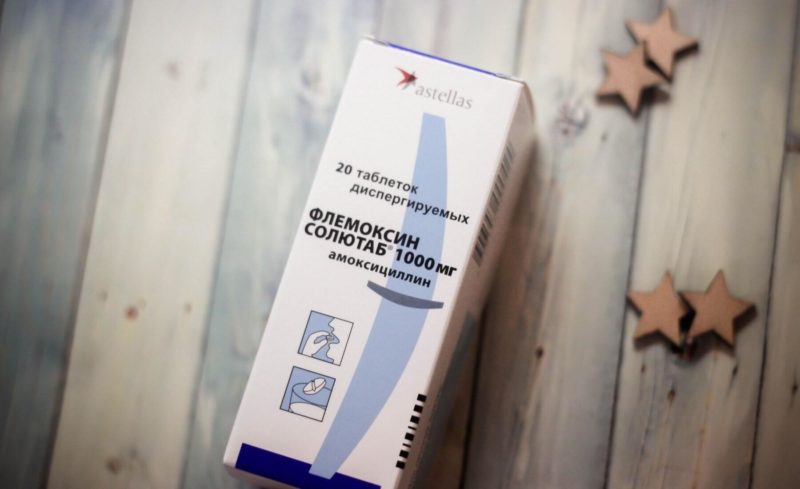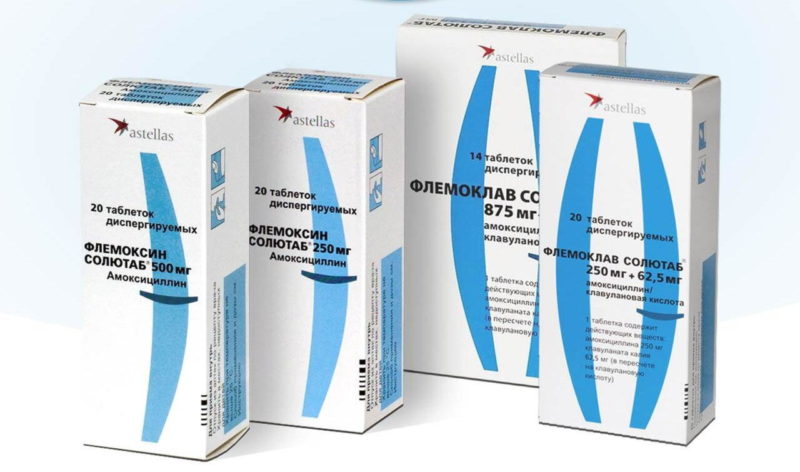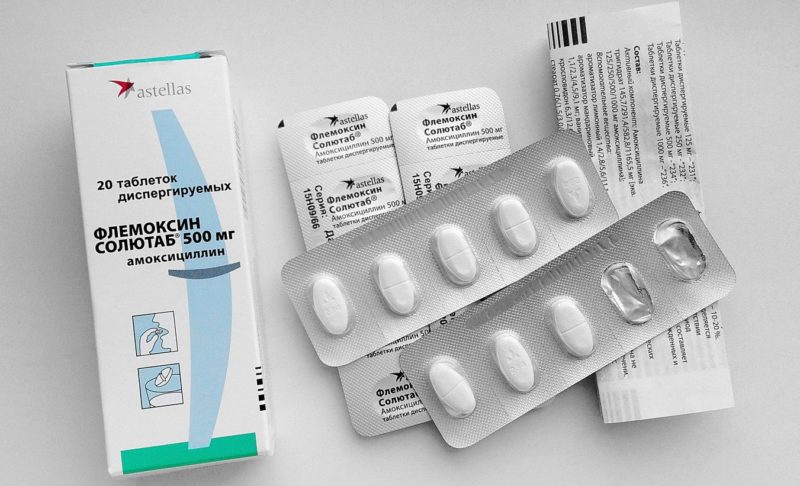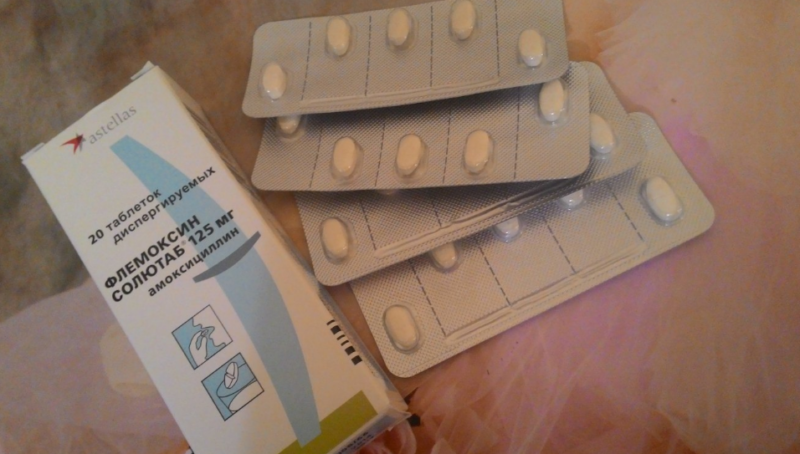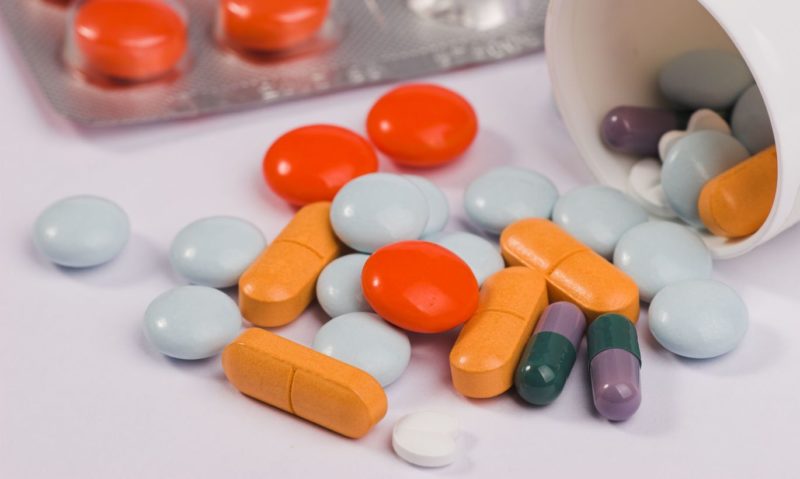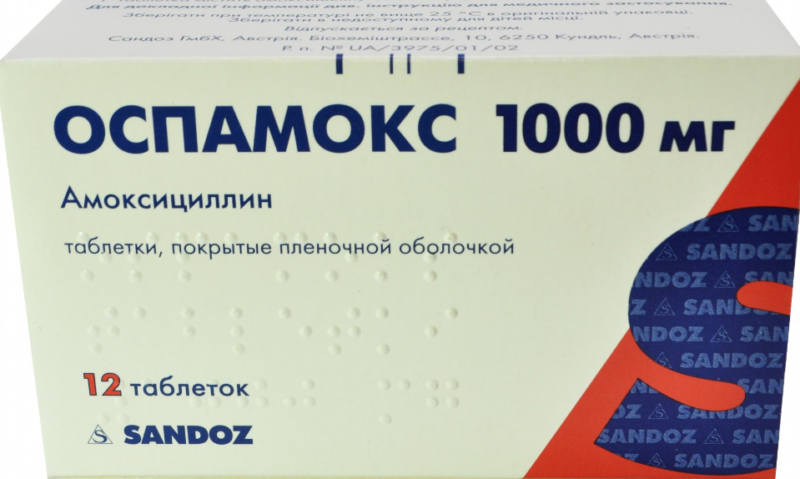In spring and autumn, the number of infectious diseases increases significantly, the treatment of which requires the use of drugs with more "heavy" artillery. The antibiotic Flemoxin Solutab is prescribed mainly for cases of bacterial infections that have not been triggered, but despite the relatively gentle effect on the body, the drug can cause a number of side effects, which are important to familiarize yourself with before taking it.
Material Content:
- 1 Release forms and composition of the antibiotic
- 2 Pharmacological action, pharmacodynamics and pharmacokinetics
- 3 In what cases is Flemoxin Solutab prescribed
- 4 Instructions for use and dosage for children and adults
- 5 During pregnancy and lactation
- 6 Drug interaction
- 7 Can I drink alcohol while taking the drug
- 8 Contraindications, side effects and overdose
- 9 Antibiotic Analogs
Release forms and composition of the antibiotic
To date, “Flemoxin Solutab” is available only in the form of large oblong tablets, which have a white or slightly gray color, rarely a yellowish tint. On the surface of the shell is engraving, and on the other side of the tablet is a transverse notch for breaking.
On the market there are pills that contain 125 mg, 250 mg, 500 mg and 1000 mg of the main active ingredient - amoxicillin.
Among other substances in the composition:
- magnesium stearate;
- sucrose;
- microcrystalline cellulose;
- silicone dioxin;
- hydroxypropylcellulose;
- flavors and flavors, for example orange or lemon;
- a small amount of vanillin.
Pharmacological action, pharmacodynamics and pharmacokinetics
Amoxicillin is active against a number of gram-positive and gram-negative microbes, including streptococci, staphylococci, shigella, salmonella and other pathogens of severe infections. Only microbes that produce beta-lactamase remain resistant. Also, the level of vulnerability of a microorganism depends on its territorial affiliation.
An advantage of amoxicillin is its ability to rapidly absorb. At the same time, about 90% of the drug is absorbed. The substance is a derivative of penicillin, but its high resistance to destruction in an acidic environment allows you to take the Flemoxin Solutab antibiotic regardless of food intake.
- The maximum amount of active component in the blood is observed after 1.5 - 2 hours.
- The rate of binding to blood proteins is 20%.
- Amoxicillin is also characterized by significant penetrating ability: it is found in sufficient concentration in bone tissues, mucous membranes and intraocular fluid.
Processing of the substance occurs in the kidneys with the formation of several metabolites. They do not affect foreign organisms, but can cause allergic reactions of varying severity.
The drug is excreted from the body using the excretory system - amoxicillin metabolites are fixed in significant volumes in the urine, insignificant volumes in the bile. On average, the half-life is from 1 to 2 hours, but the indicator increases with decreasing age: in children under six months of age, children with insufficient body weight it is less than 4 hours. With kidney problems, the half-life of the drug reaches 9 hours.
In what cases is Flemoxin Solutab prescribed
Flemoxin Solutab is a universal medicine for infectious diseases that are caused by gram-negative or gram-positive bacteria, and affect such organ systems:
- respiratory
- digestive
- excretory system and genitals;
- integuments, soft tissues.
“Flemoxin Solutab” is suitable for children from one year old who have symptoms of microbial diseases, but it is important to follow all the instructions and recommendations of the doctor.
Instructions for use and dosage for children and adults
The duration and dose of taking Flemoxin Solutab depend on the type and degree of neglect of the disease, the resistance of the pathogen and the age of the patient.
Standard dosages are listed below.
The doctor, if necessary, can adjust the therapy, so it is the instructions of a specialist that are priority.
| Patient age | Single dose (mg) | The number of receptions per day |
|---|---|---|
| Up to 1 year | 30-60 per 1 kg of body weight | 2/3 |
| 1 to 3 years | 250/125 | 2/3 |
| 3 to 10 years | 375/250 | 2/3 |
| From 10 years and more | 500-750/375-500 | 2/3 |
The proposed table shows the optimal amount of active substance for the treatment of bacterial diseases in mild or moderate severity (for example, tonsillitis, sinusitis, cystitis, uncomplicated otitis media). In the latter case, it is better to give preference to three times a day.
For more severe microbial damage to the body, it is recommended to increase a single dose to 750-1000 mg (3-4 tablets Flemoxin Solutab 250 mg or 1.5-2 tablets containing 500 mg of amoxicillin) and carry out therapy with an interval of 6-8 hours. For children, the maximum amount of product leaves 60 mg per 1 kg of weight.
With uncomplicated gonorrhea, Flemoxin Solutab therapy is supplemented with 1000 mg of probenecid (per 3000 mg of amoxicillin).
The course is usually up to one week, but if the body is affected by one of the types of streptococci, then the therapy is extended to 10 days.
A feature of the drug is its release form. These are dispersible tablets that dissolve in the oral cavity. You can swallow dragees whole, you can pre-break, dissolve for a short period of time or dissolve in a tablespoon of water at room temperature.
During pregnancy and lactation
There is evidence of the ability of amoxicillin to cross the placenta, but its degree of influence on the fetus has not been determined, so there are no specific prohibitions on the use of the drug during pregnancy. The doctor may prescribe such therapy if he considers that there are no safer analogues.
As for breastfeeding, during treatment with Flemoxin Solutab it is recommended to refuse this - amoxicillin passes into breast milk and the likelihood of developing complex forms of allergies in infants is high.
Drug interaction
Antibiotics are active substances that easily react with other drugs, affecting the functioning of the body in one way or another.
Details of the possible consequences can be found in the table below.
| A drug | Manifestation with Flemoxin Solutab |
|---|---|
| "Digoxin" | Increased absorption of funds |
| Other antibiotics | Synergy phenomenon |
| Bacteriostatic agents | Suppression of action of both antibiotic and drug |
| Anticoagulants | Enhancing their effect |
| NSAIDs, allopurinol, probenecid, phenylbutazone, diuretics | Longer removal of the antibiotic from the body, an increase in the amount of amoxicillin in the blood |
| Laxatives, antacids, aminoglycosides, glucosamine | Decreased absorption of the antibacterial drug |
| High Vitamin C Foods | Increased absorption |
| Estrogen Based Oral Contraceptives | Decreased contraceptive effect, high probability of uterine bleeding |
Can I drink alcohol while taking the drug
During antibiotic therapy, the use of ethanol-containing drinks is strictly prohibited, as this is fraught with undesirable consequences.
- First, alcohol can reduce the effectiveness of antibiotics, so amoxicillin will not have the proper therapeutic effect, exacerbating the symptoms of a bacterial disease.
- Secondly, the combination of alcohol and Flemoxin Solutab has an extremely negative effect on the state of the digestive system: antibiotics disrupt the intestinal microflora, and ethanol irritates it, which subsequently leads to gastrointestinal disorders, the development of colitis, enterocolitis, and ulcers.
- Thirdly, the liver takes the greatest load. Amoxicillin inhibits the synthesis of the enzyme, which is responsible for the processing of foreign substances. As a result, the body is exposed to toxins, which results in cirrhosis of varying severity or liver necrosis.
Contraindications, side effects and overdose
Of the contraindications, there is only a ban on the use of allergy sufferers or people who have residual consequences of the use of antibiotics from the genus of penicillins, for example, enterocolitis against a background of dysbiosis.
Side effects affect various body systems, as set out in the table.
| Organ system | Feasible side effects |
|---|---|
| Excretory, sexual | Crystalluria (high salt content in urine), interstitial nephritis, vaginal candidomycosis |
| Immune | Urticaria, itching, characteristic maculopapular rashes, hyperemia, fever, angiitis (vascular inflammation), arthralgia (muscle and joint pain), extremely rare - anaphylactic shock, severe skin adverse reactions like Stevens-Johnson syndrome, epidermal necrolysis or exanthematous pustulosis, angioedema |
| Nervous | Insomnia, asthenia (prolonged fatigue), mood changes, peripheral neuropathy (spontaneous appearance of tingling sensations, burning, weakness, numbness in the limbs), cramps, pain in the head, confusion |
| Digestive | Dyspeptic disorders, changes in taste perception, dysbiosis, stomatitis, rarely - jaundice, hepatitis, pseudomembranous colitis |
| Hematopoiesis | Neutropenia, thrombocytopenia or thrombocytopenic purpura, anemia, eosinophilia |
An overdose of amoxicillin most often manifests itself as normal poisoning - gastrointestinal disorders, dehydration, and fever.
There is no specific treatment, but it is important to wash the stomach in time and give the patient activated charcoal, if necessary, call a doctor.
Antibiotic Analogs
An allergic reaction to the drug, gastrointestinal diseases are possible reasons for replacing Flemoxin Solutab with a similar remedy.
Structural analogues based on amoxicillin can have various combinations of excipients, therefore, they are prescribed for hypersensitivity to additional components.
Among them:
- Ospamox;
- Gonoform;
- Amoxicillin;
- "Graximol";
- Hikontsil;
- Amofact;
- Amoxicillin.
Doses for the above drugs coincide with the standards for Flemoxin Solutab, but it is worth considering the differences in the form of release (for example, some are sold in powder or capsule form) and manufacturers.
Analogs of Flemoxin Solutab may include other active components, for example, ampicillin. The substance is another "relative" of penicillin. The list of indications is almost the same, but fewer bacteria are vulnerable to the latter. The main advantage of the drug is the ability to treat pregnant women.
As substitutes, all antibiotics that are effective in killing a particular bacterium are suitable, but you can not choose an analog on your own - only under the guidance of your doctor.
Flemoxin Solutab is one of the most popular antibiotics in medical practice. But despite the frequency of its use, it is important to treat therapy with caution - the drug causes a number of complex adverse reactions.


